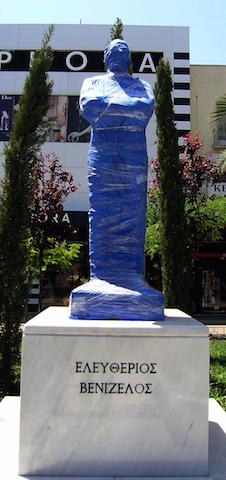Interview by MODESTA DI PAOLA

Some color for nature.
Why public art?
Because public street art is the only art that can communicate with everyone without considering the history of art, or the education background of each viewer.
Public art is the oldest-newest way for everyone to feel that the streets belong to everybody, no borders, no limits, no leaders. If you have something to say, just say it!
In our era, with those moral conflicts and the crisis of our values in our countries, we need more public art, more artists and for sure, better artworks in the streets.
Who is the “public” in public art?
The "public" for me is the viewers, the place, and the artwork at the same time. Because someone can see the viewer watching the artwork from a distance in the public space and understand those three components as one (installation projects).
I don’t think that I can separate those three “ingredients” from the public art. I think that the "public" will always be those three components throughout time.
Of course at the same time I know from my experience on the streets doing artworks, that every individual “viewer” understands the “public” with a slight different point of view.

Athens 2010- New age politicians.
What is the “art” in public art?
"Art" in the "public art" is the aesthetic proposal that can reconstruct an idea, or a meaning in colours, forms, rhythm, symbols, etc., through the "language" from the artist in the material world.
So from this point of view "art" (in the public art) is an urban language that tries to communicate with all the viewers in the public landscape. This task is not easy. In the museums you always have papers, catalogues, texts etc. that explains to you everything throughout, the language of the artist, the language of art. In public space, you don’t have those convenient explanations, so every viewer stands alone, trying to understand what he/she sees, what he/she feels and if he/she likes it or not.
So, maybe "art" in the public space is something that can make you feel or understand yourself better, or, feel and understand the people of the city, the situation that you live in or the environment. Of course "art" is always a dream that comes true through the representative theme. Art is always the border or the mirror of your public understanding.

Wrong path.
Where is the space for public art?
Everywhere. Based on the paths of the history of other artists. Let me explain more or less what I am talking about. Public art can create reforms, statements, communication for political and other issues… it can create monuments, sculptures, graffiti, murals, installations, happenings etc. I don’t believe in the idea that monuments, or sculptures in the public space must be vandalized in any way from “public art”. I don’t expect from the “viewer” to understand the history of art, or the landscape of art, but for the artist it is very important. Without the respect of those borders, public art is no more public. When you make art for yourself, it is always about your ego and the space is small, when you make art for the world, you see clearly the landscape and the limits, the space and the borders of public art because you “work” for everyone. So if you want to know where is the space for public art. I can say, everywhere. In you, in me, in our values and our understandings. Anywhere, everywhere but always with respect and critical thinking.

Athens_Graffiti.
When is it public art?
So as a conclusion, public art is there to reshape our critical thinking, to communicate our deepest thoughts and our strongest social statements. Every time an artwork in the public space helps us reform our inner thoughts, make us concentrate to what matters the most, make as dream, then this a good example of public art.
In our days of course, public art for most of the people can be anything, anywhere, but as I said, from my point of view, public art must have something to say, it must create the environment for the viewer to concentrate and at the same time create critical thinking. With those two components, concentration and critical thinking artists and viewers understand better not only the public art, but also the world. So, public art can create a better world through the viewer and certainly through the artists. When those two meet in the public space, the public art is there. If you have something to say, just say it.


